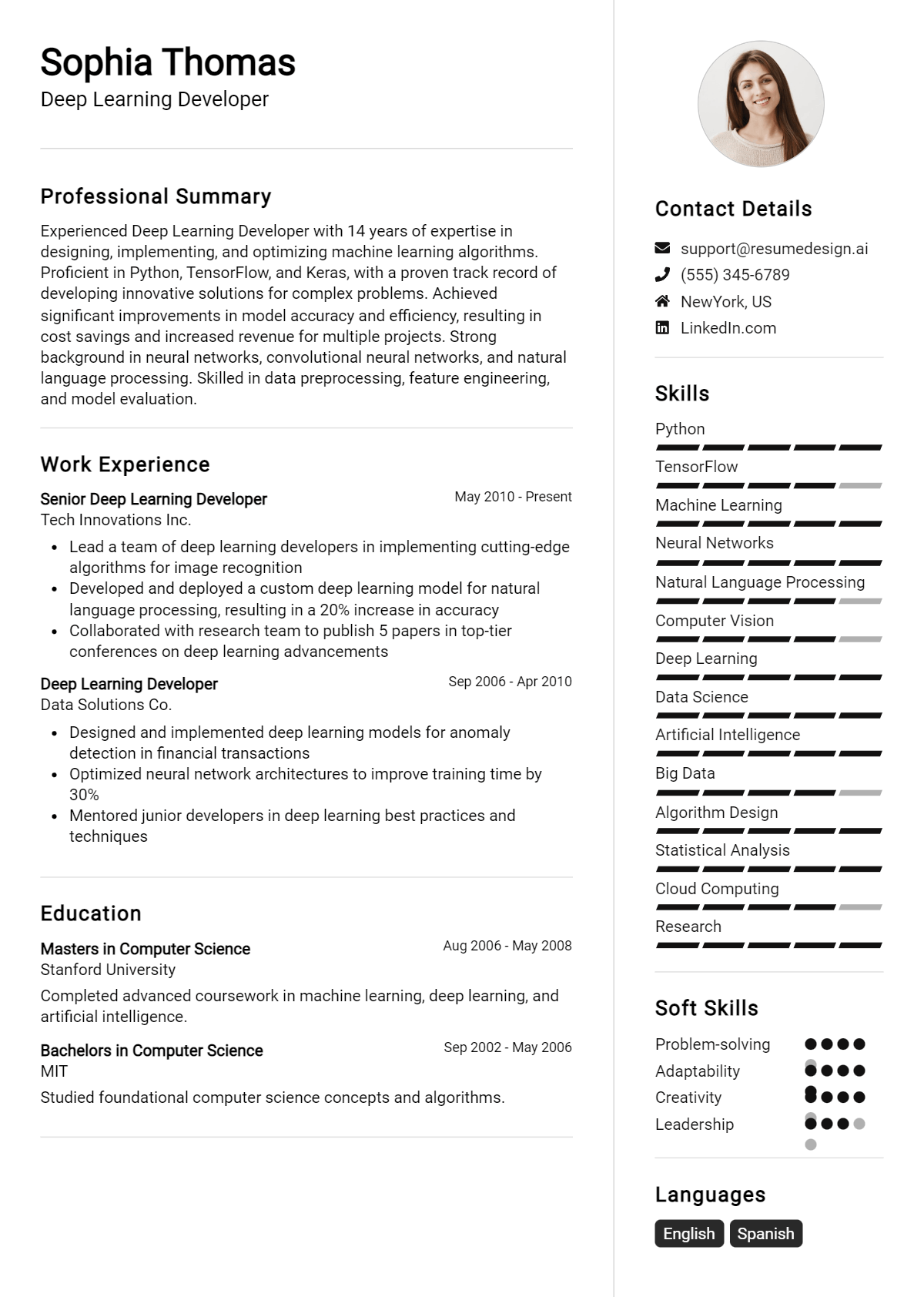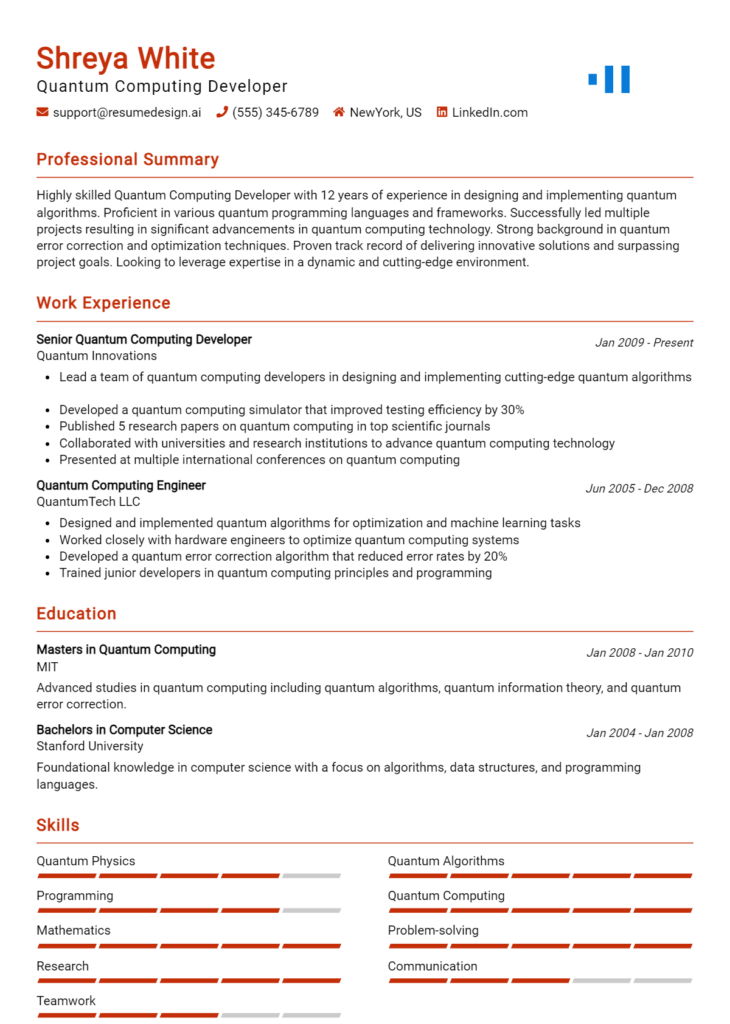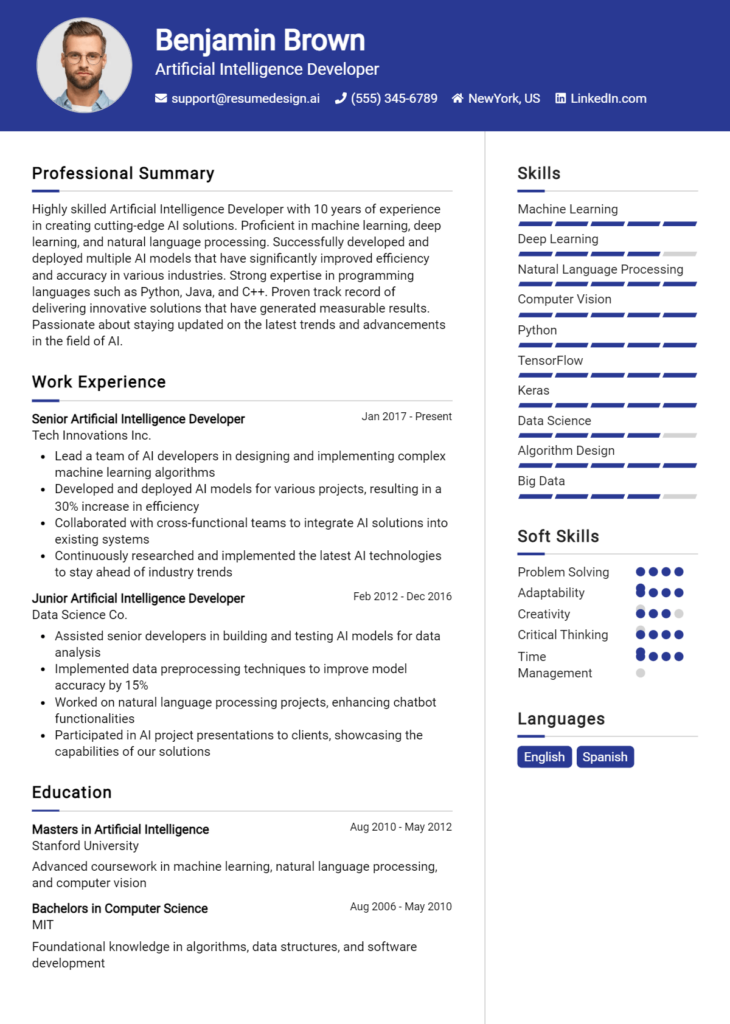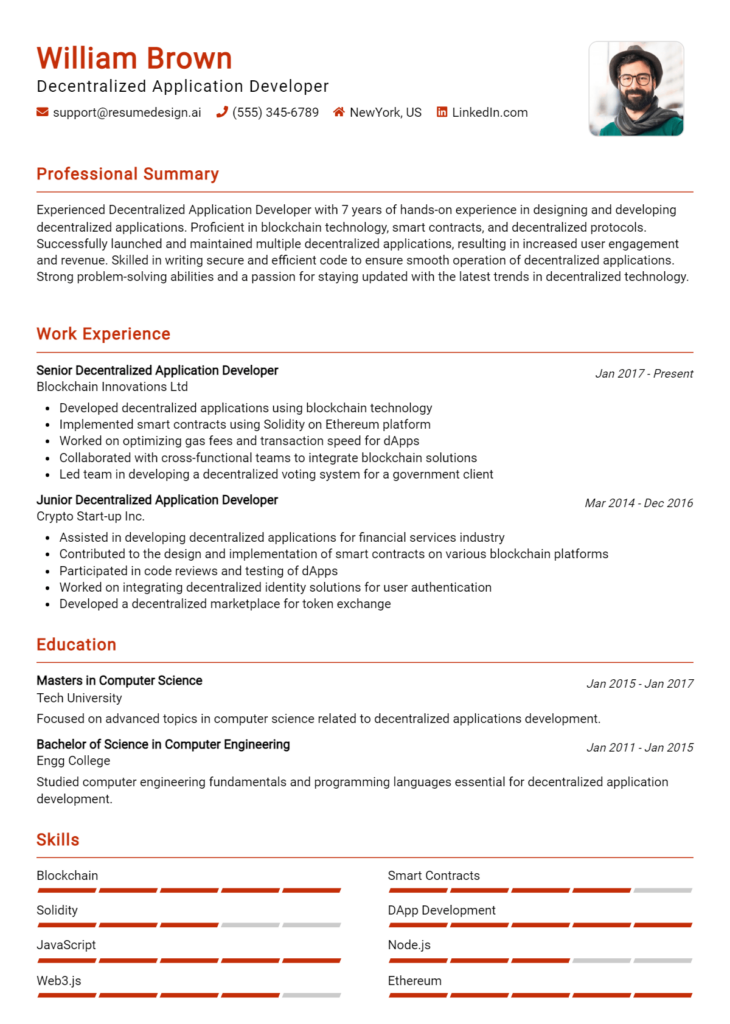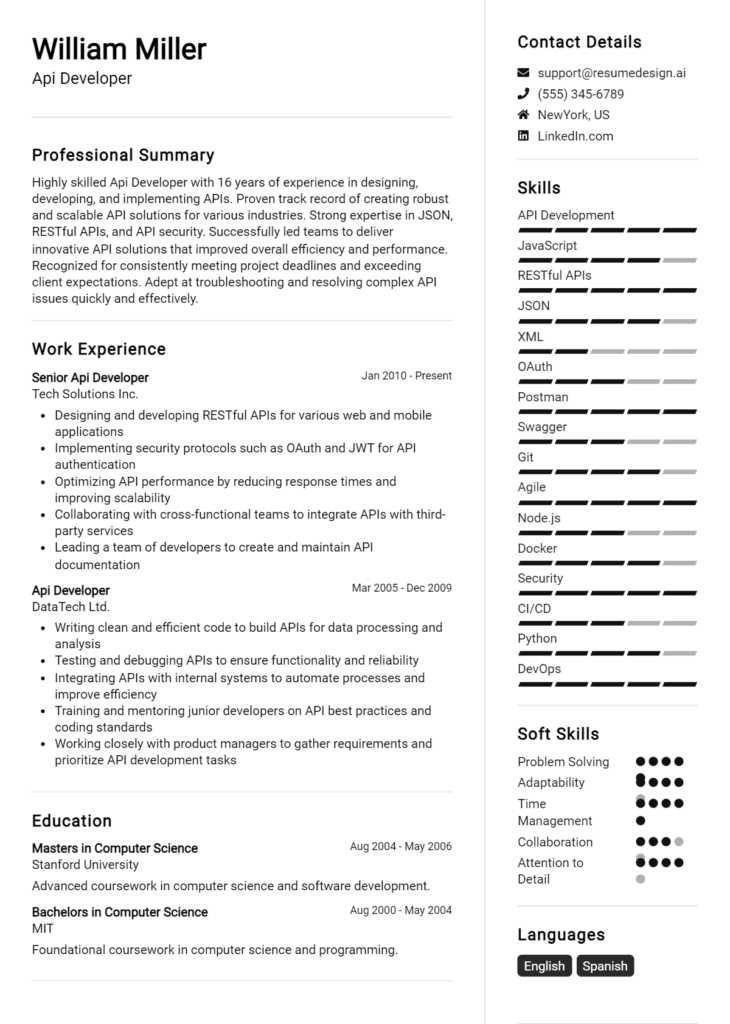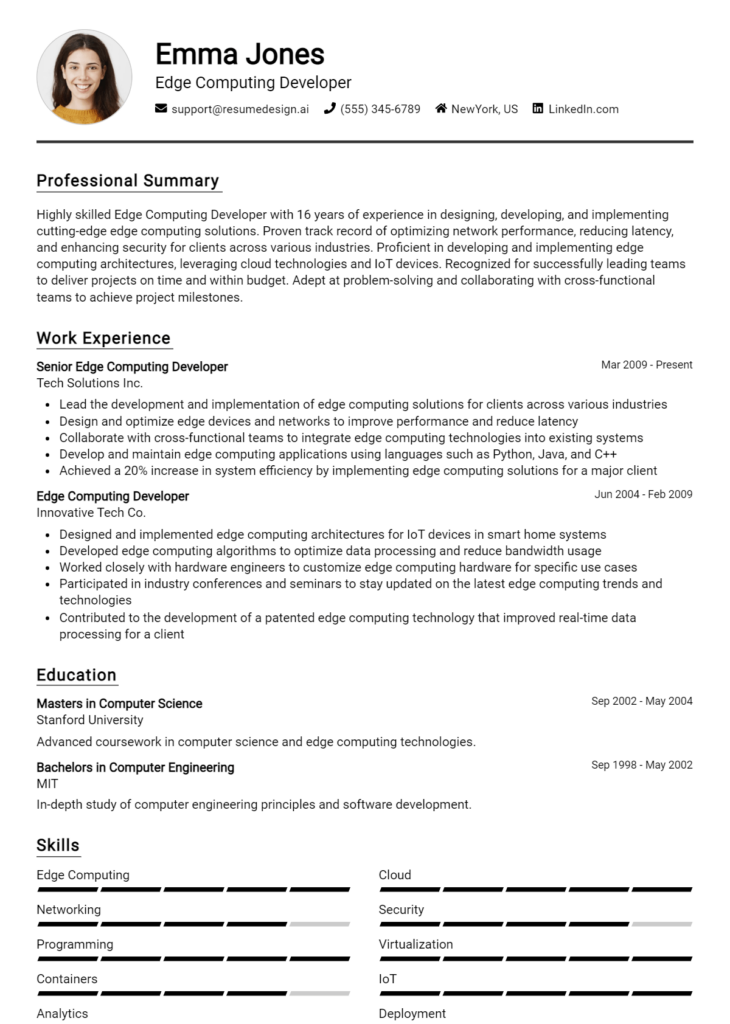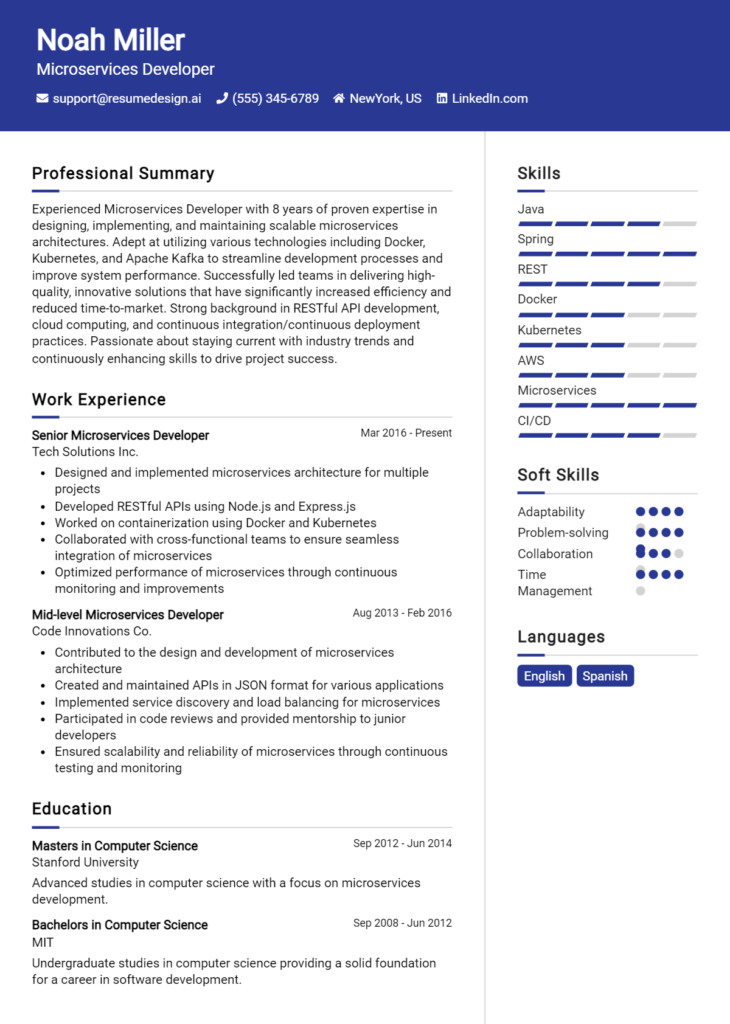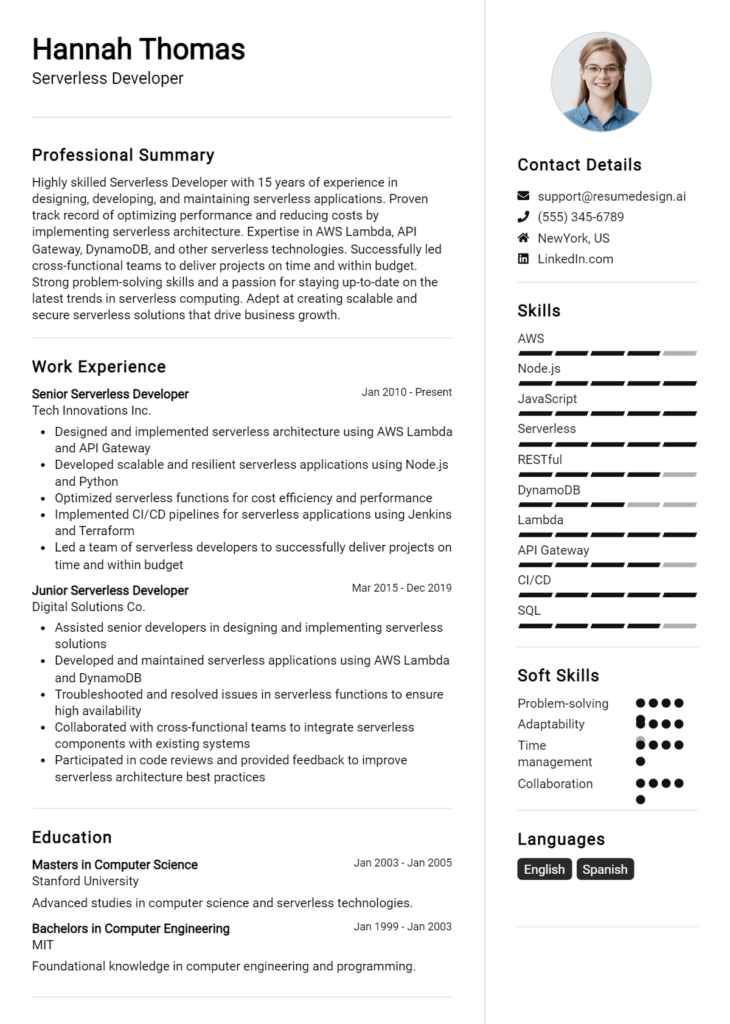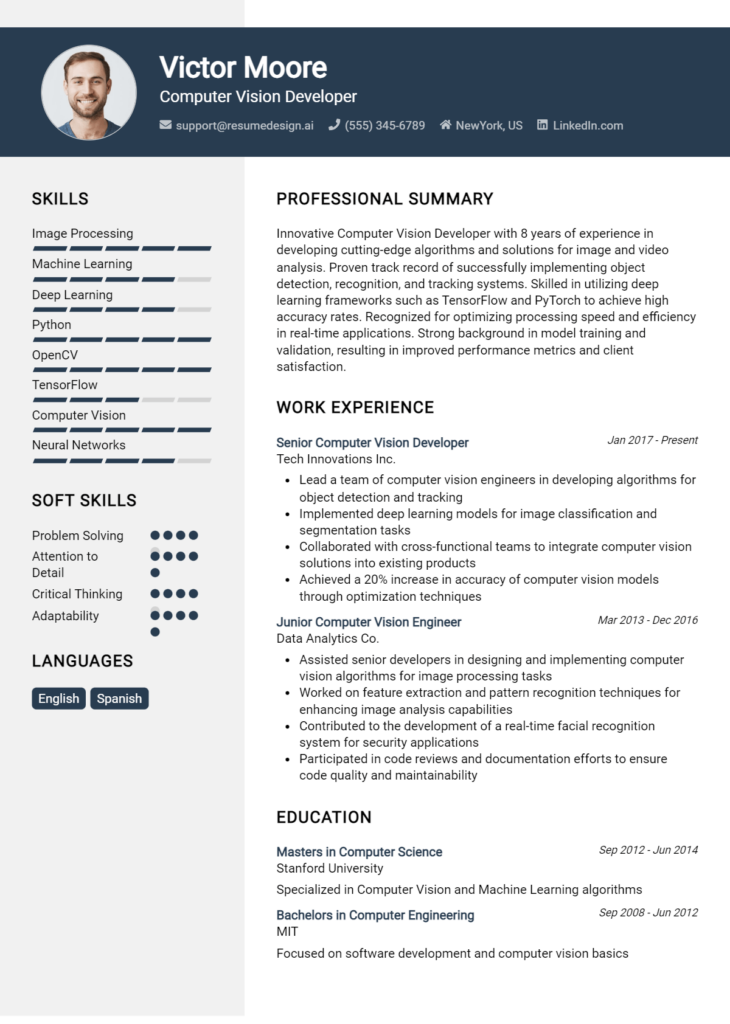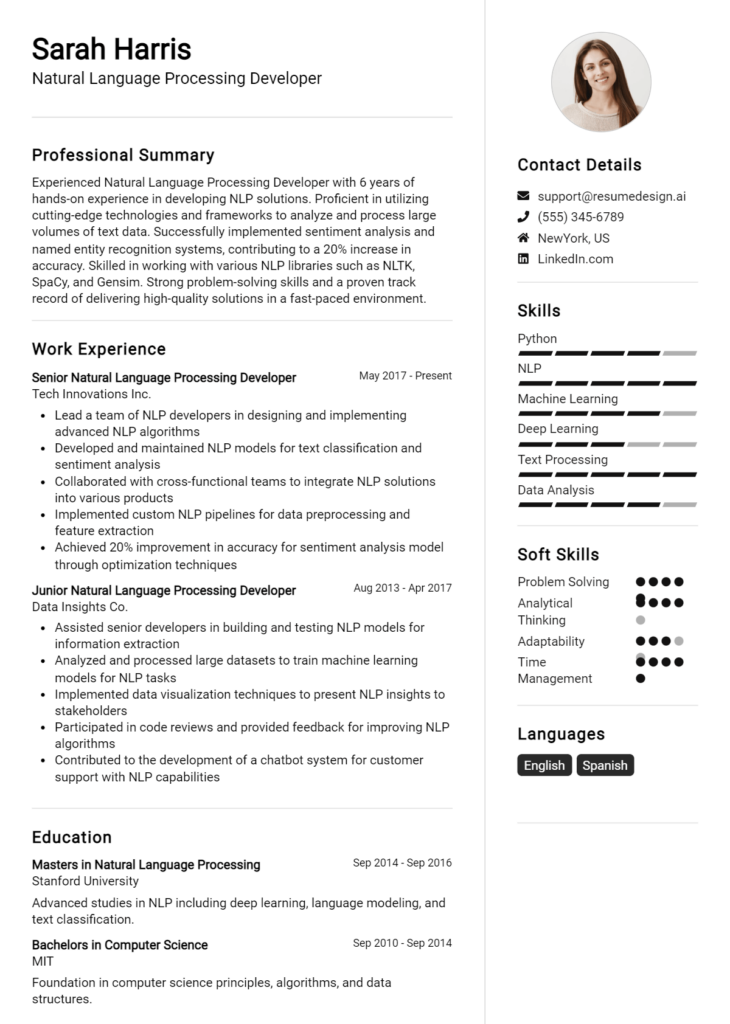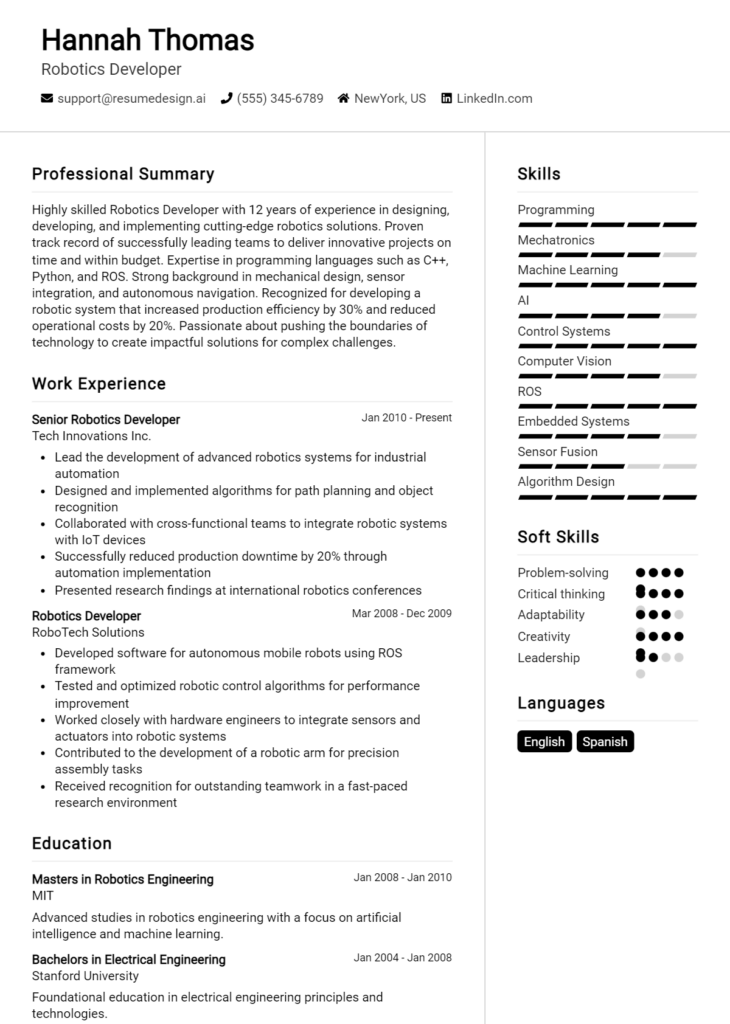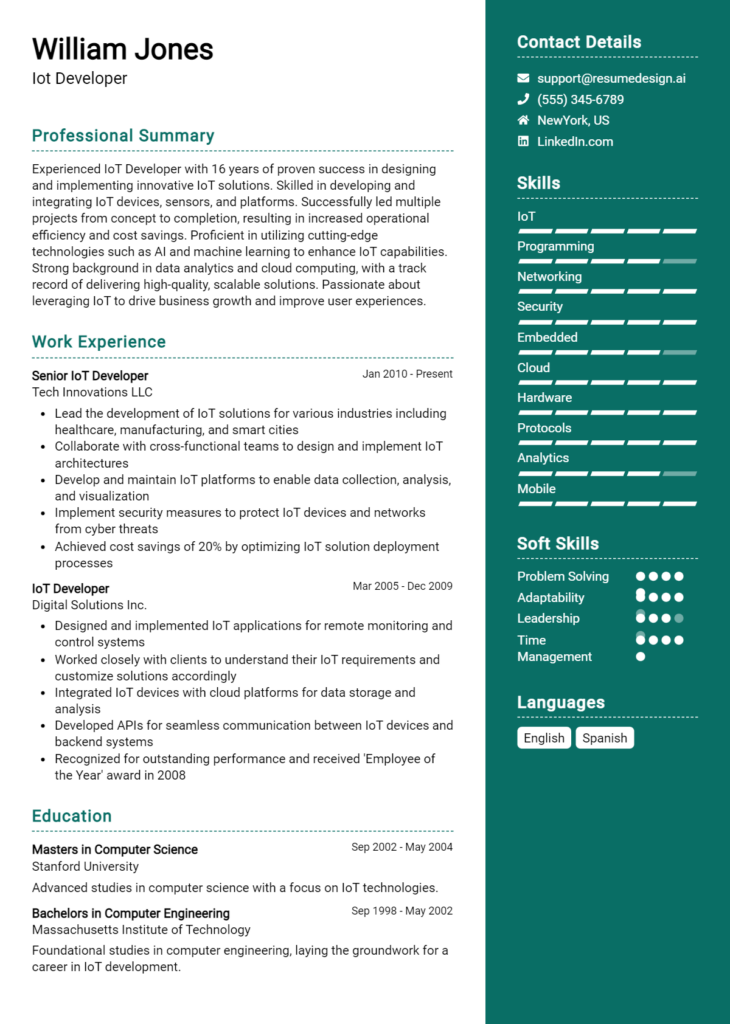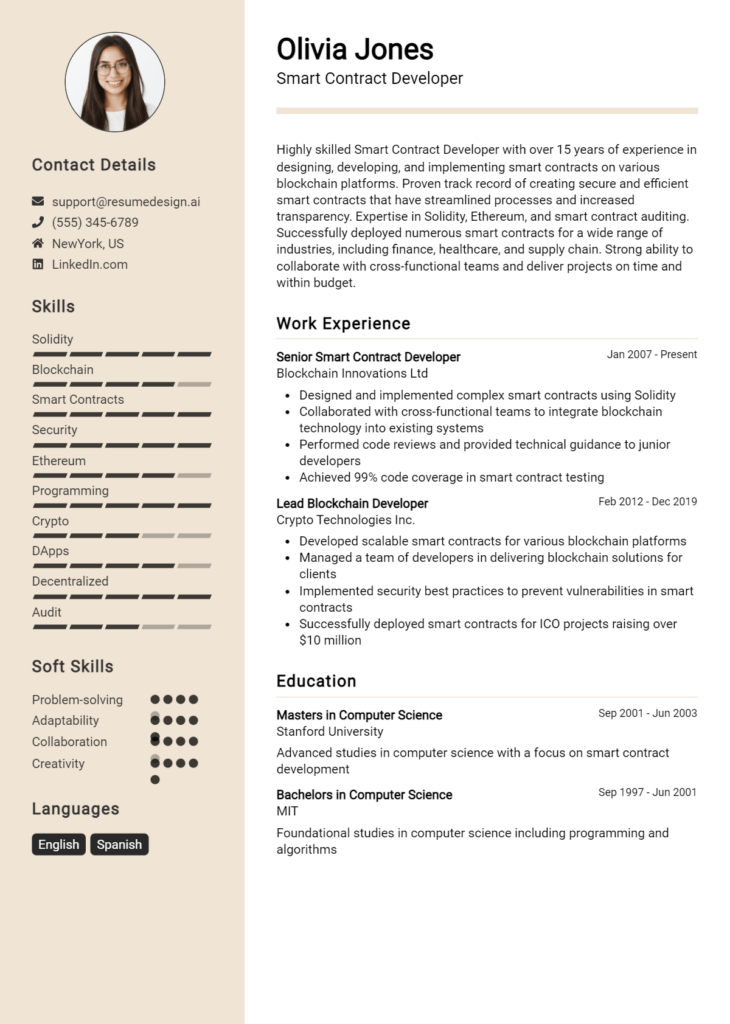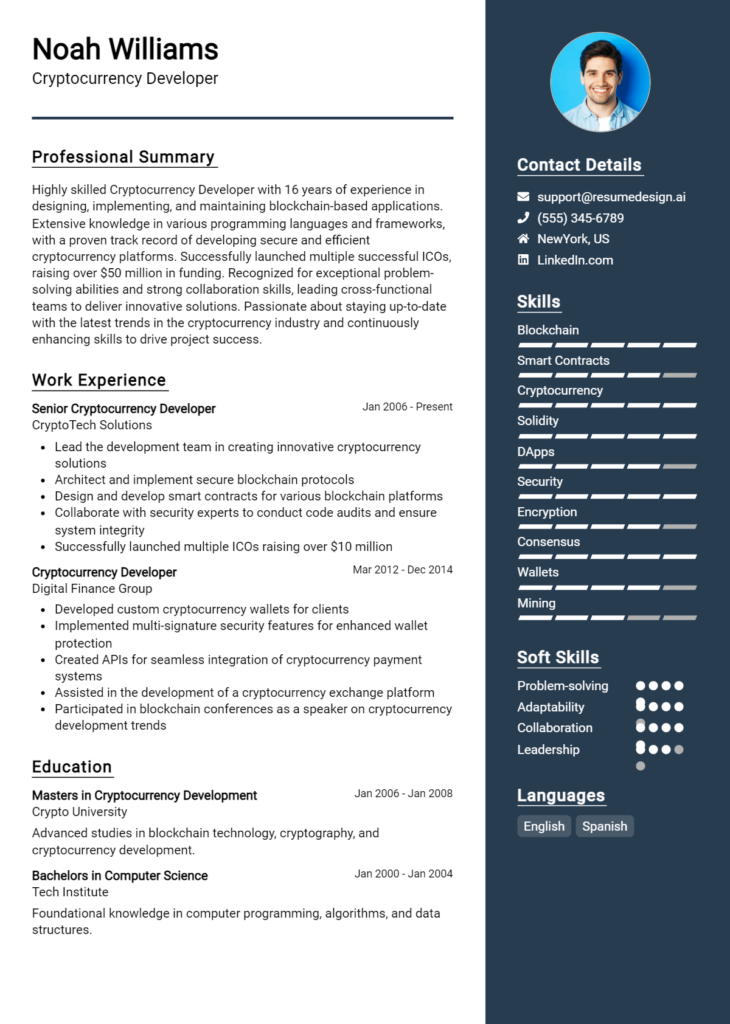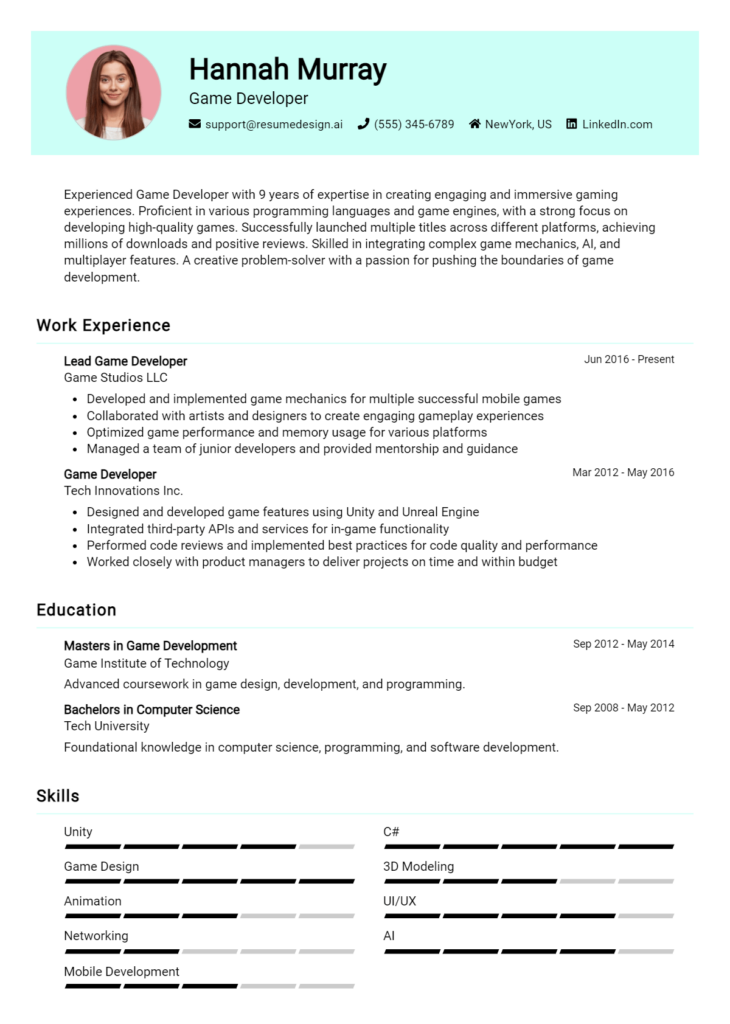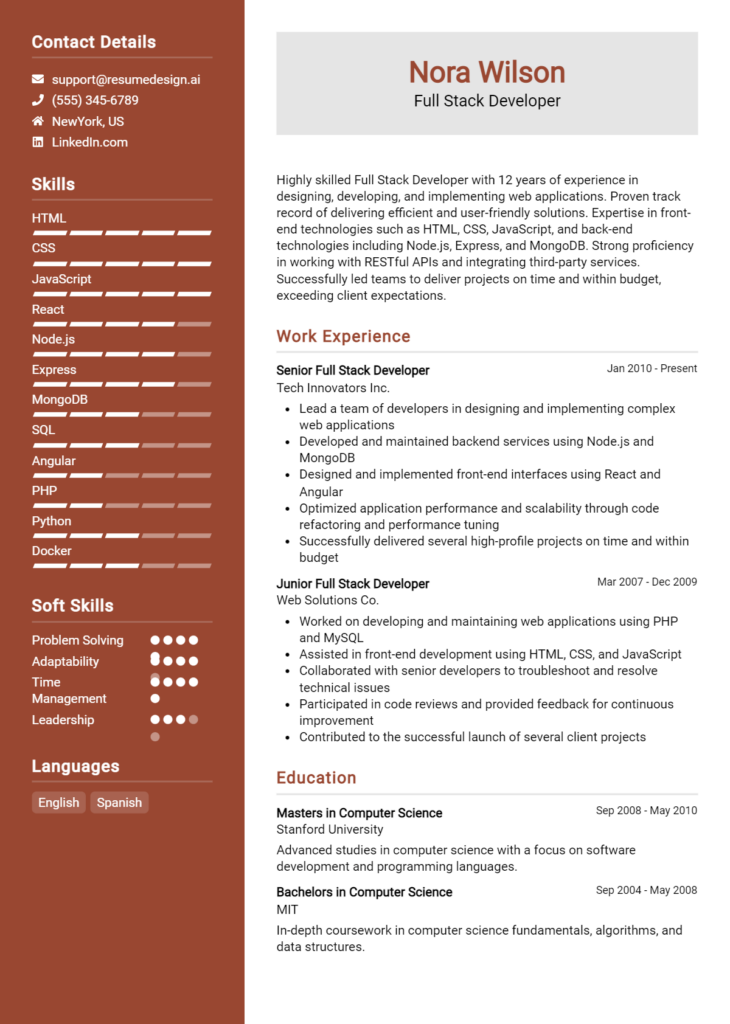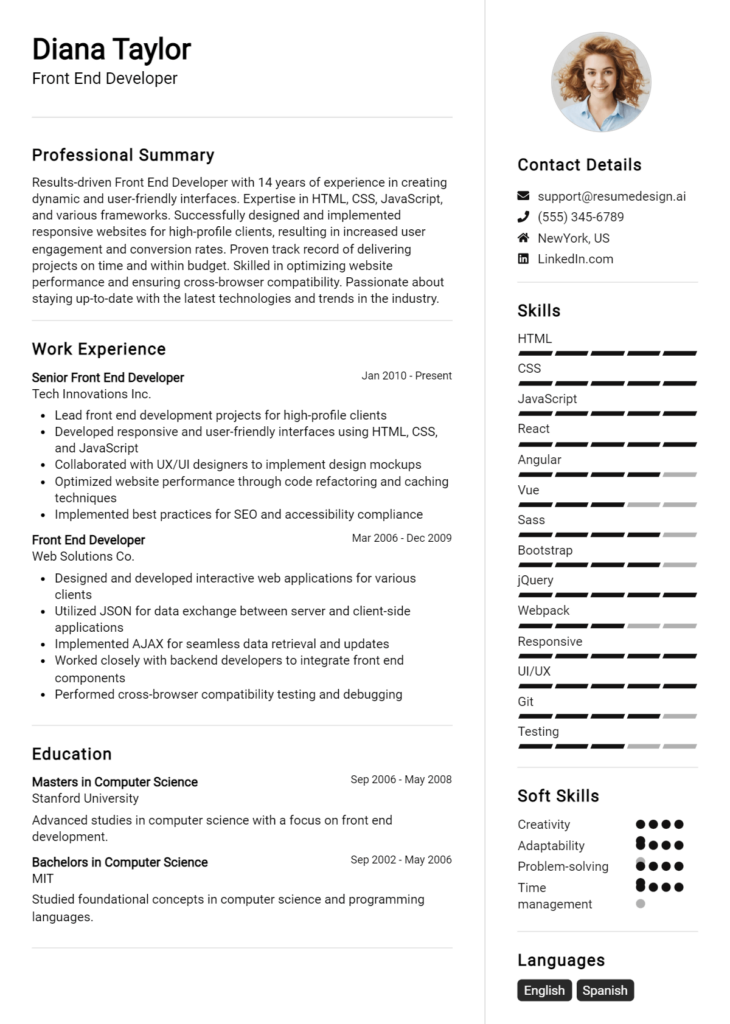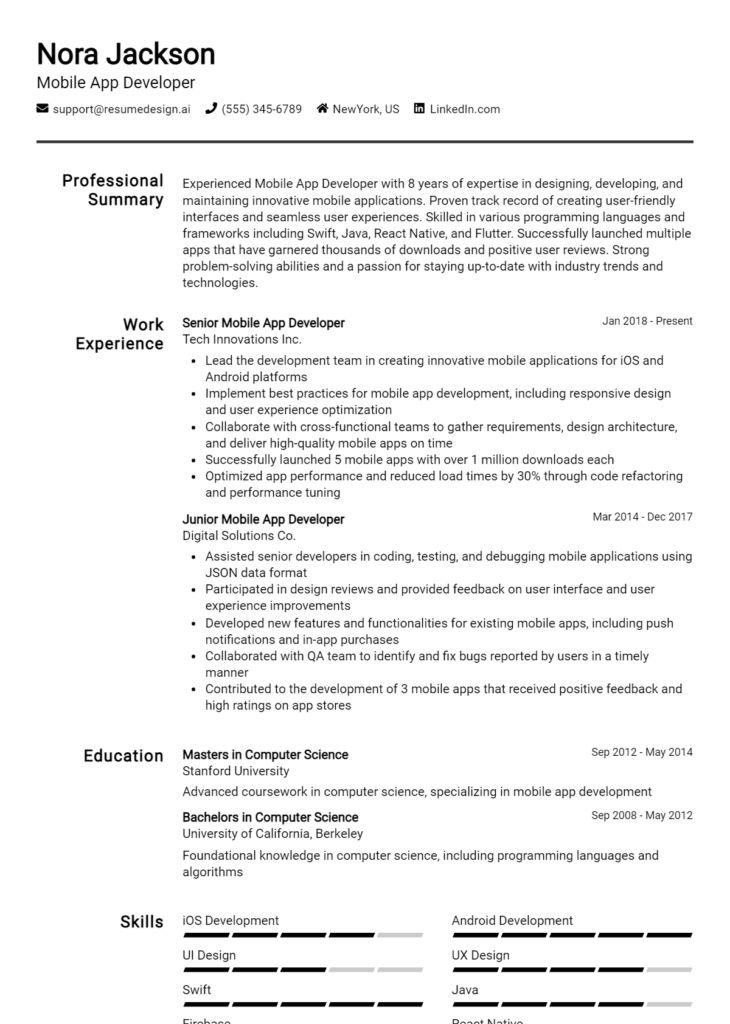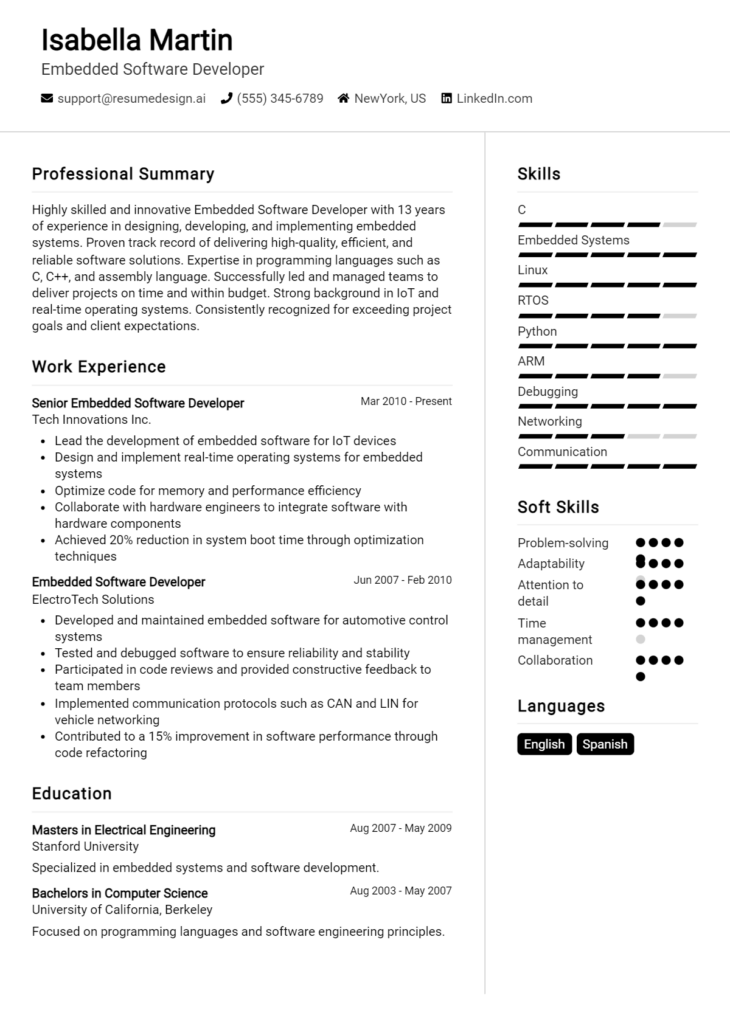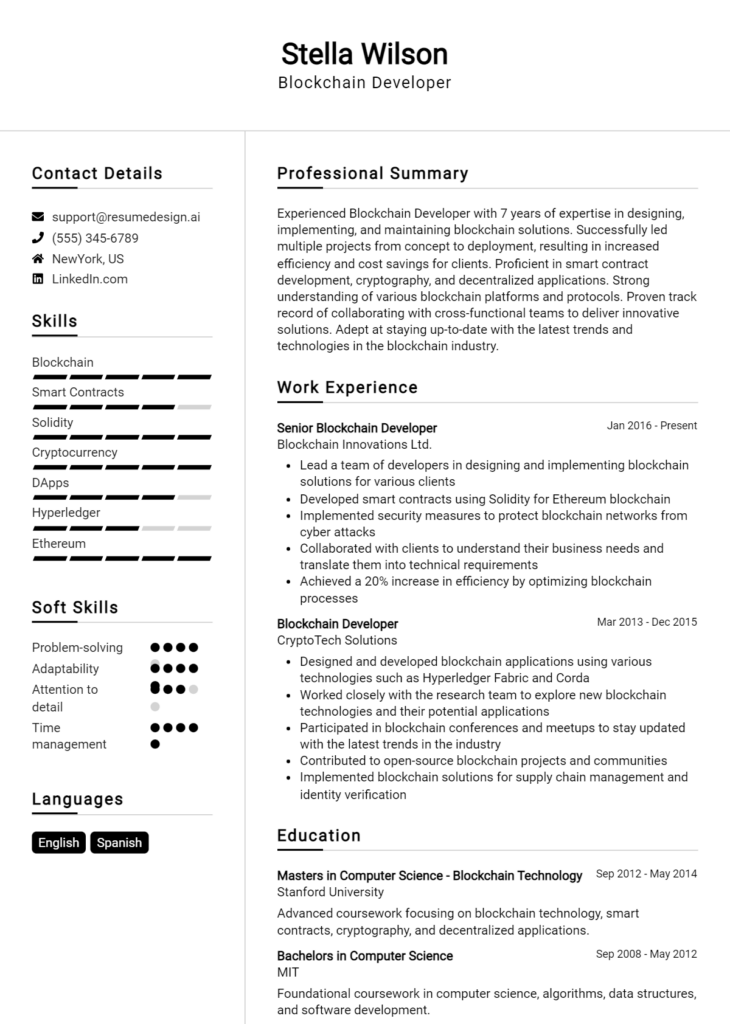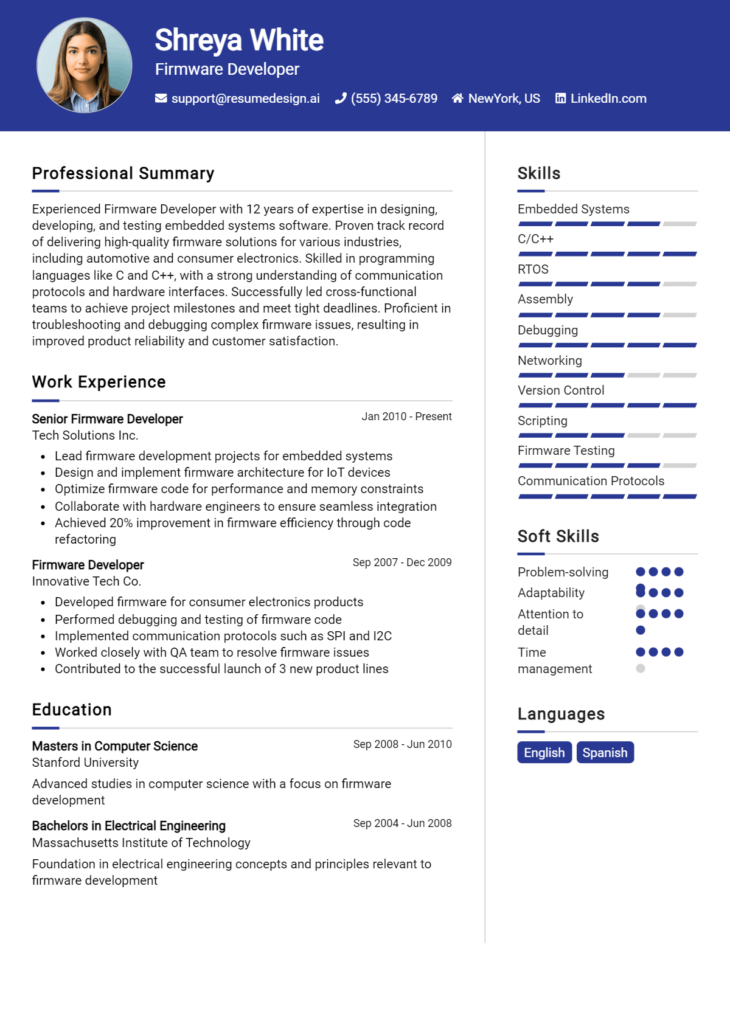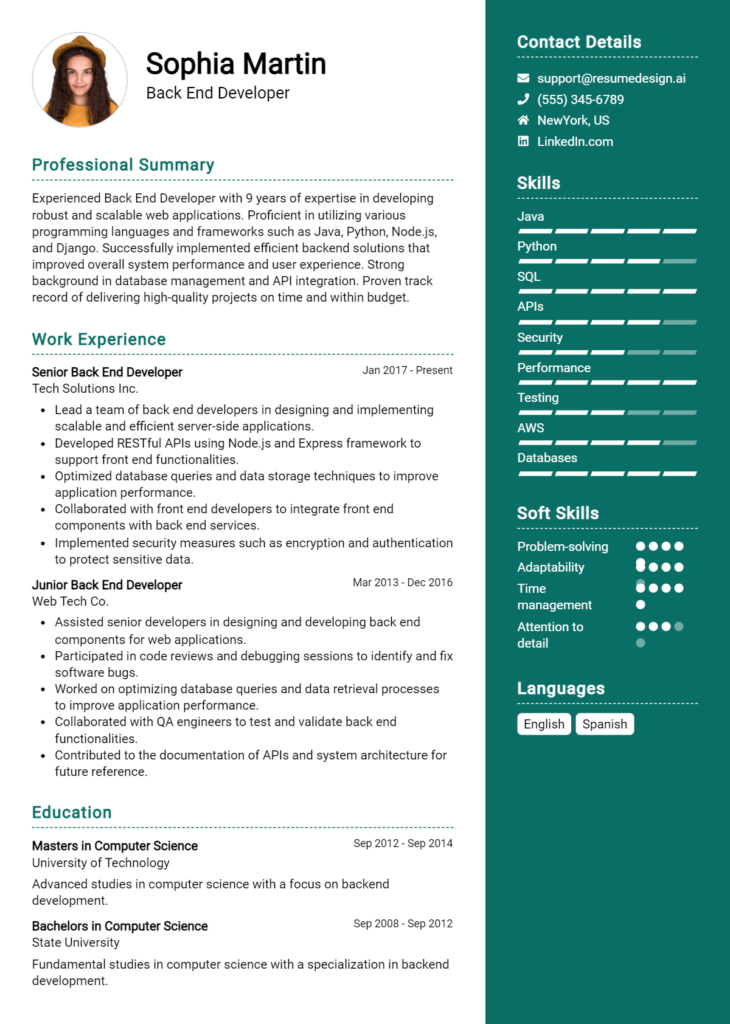Deep Learning Developer Core Responsibilities
A Deep Learning Developer plays a pivotal role in leveraging machine learning technologies to solve complex problems across various departments, including engineering, data science, and product development. Key responsibilities include designing and implementing neural networks, optimizing algorithms, and analyzing large datasets to extract meaningful insights. Essential skills encompass strong programming proficiency, operational efficiency, and advanced problem-solving abilities. These competencies are crucial for aligning technical solutions with organizational goals, and an effectively structured resume can highlight these qualifications to prospective employers.
Common Responsibilities Listed on Deep Learning Developer Resume
- Design and develop deep learning models for classification, regression, and other tasks.
- Optimize existing algorithms for improved performance and efficiency.
- Collaborate with cross-functional teams to integrate deep learning solutions into products.
- Conduct experiments and analyze results to refine models and techniques.
- Preprocess and augment datasets to enhance training effectiveness.
- Implement frameworks such as TensorFlow, PyTorch, or Keras for model development.
- Stay updated with the latest advancements in deep learning and AI technologies.
- Document processes and findings for knowledge sharing within the organization.
- Provide support and troubleshooting for deployed deep learning applications.
- Conduct code reviews and ensure adherence to best practices in software development.
High-Level Resume Tips for Deep Learning Developer Professionals
In today's competitive job market, a well-crafted resume is essential for Deep Learning Developer professionals looking to make their mark. Your resume serves as the first impression you make on potential employers, and it must effectively reflect both your technical skills and your notable achievements in the field. A strong resume not only showcases your qualifications but also tells your unique story as a developer. This guide will provide practical and actionable resume tips specifically tailored for Deep Learning Developer professionals, ensuring that you stand out in a sea of applicants.
Top Resume Tips for Deep Learning Developer Professionals
- Tailor your resume to the job description by incorporating relevant keywords and phrases that match the specific requirements of the position.
- Highlight your experience with deep learning frameworks such as TensorFlow, Keras, and PyTorch, ensuring that they are prominent in your skills section.
- Quantify your achievements by using metrics to illustrate your impact, such as improvements in model accuracy or reductions in processing time.
- Showcase relevant projects in a dedicated section, including links to your GitHub or portfolio to demonstrate your hands-on experience.
- Include any relevant certifications, courses, or training in deep learning and artificial intelligence to validate your expertise.
- Emphasize your problem-solving abilities by detailing specific challenges you faced in past projects and how you overcame them.
- Highlight collaboration skills by mentioning teamwork experiences, particularly in cross-functional teams or open-source contributions.
- Keep your resume concise and focused, ideally one page, to ensure that hiring managers can quickly identify your strengths.
- Use clear and professional formatting, making it easy to scan through your resume and find key information at a glance.
By implementing these tips, you can significantly increase your chances of landing a job in the Deep Learning Developer field. A well-organized and tailored resume not only showcases your qualifications but also conveys your passion for deep learning, setting you apart as a compelling candidate in a growing industry.
Why Resume Headlines & Titles are Important for Deep Learning Developer
In the competitive field of deep learning development, a well-crafted resume headline or title is crucial for standing out in a sea of applicants. A strong headline serves as a powerful first impression; it captures the attention of hiring managers and summarizes a candidate's key qualifications in a concise, impactful phrase. It should be relevant to the specific position being applied for and immediately convey what the candidate brings to the table, such as their expertise in neural networks, programming languages, or significant project accomplishments. A compelling headline not only piques interest but also sets the tone for the resume, encouraging hiring managers to delve deeper into the applicant's experience and skills.
Best Practices for Crafting Resume Headlines for Deep Learning Developer
- Be concise: Limit your headline to a single impactful sentence or phrase.
- Be role-specific: Tailor your headline to align directly with the deep learning developer position.
- Highlight key skills: Include specific technical skills that are relevant to the role.
- Showcase accomplishments: Mention notable achievements or projects that demonstrate your expertise.
- Use industry keywords: Incorporate terms commonly used in the deep learning field to catch the hiring manager’s attention.
- Avoid clichés: Steer clear of generic phrases that do not add value to your application.
- Maintain professionalism: Ensure your headline reflects your professional persona and aligns with industry standards.
- Keep it dynamic: Use action-oriented language to convey enthusiasm and capability.
Example Resume Headlines for Deep Learning Developer
Strong Resume Headlines
Innovative Deep Learning Developer with 5+ Years of Experience in Neural Networks and Computer Vision
Results-Driven AI Specialist Skilled in TensorFlow and PyTorch with a Proven Track Record in Predictive Modeling
Expert Deep Learning Engineer with a PhD in Machine Learning and 10+ Successful Deployments of AI Solutions
Weak Resume Headlines
Experienced Programmer Seeking Opportunities
Deep Learning Developer
The strong headlines are effective because they are specific, highlighting relevant skills and experiences that directly relate to the deep learning developer role. They create a sense of credibility and demonstrate the candidate's value proposition clearly. In contrast, the weak headlines fail to impress because they are vague and generic, lacking the detail and focus needed to catch the eye of hiring managers. These non-specific titles do not convey the unique strengths or contributions the candidate can make, which diminishes their overall impact and effectiveness.
Writing an Exceptional Deep Learning Developer Resume Summary
In the competitive field of deep learning, a well-crafted resume summary serves as a critical tool for job seekers. This brief yet powerful introduction allows candidates to quickly capture the attention of hiring managers by showcasing their key skills, relevant experience, and significant accomplishments in the domain. A strong summary acts as a hook, compelling employers to delve deeper into the candidate's qualifications. It should be concise, impactful, and meticulously tailored to align with the specific job description, ensuring that the applicant stands out in a crowded applicant pool.
Best Practices for Writing a Deep Learning Developer Resume Summary
- Quantify Achievements: Use numbers to demonstrate the impact of your work, such as improved model accuracy or reduced processing time.
- Focus on Relevant Skills: Highlight technical skills pertinent to deep learning, such as proficiency in TensorFlow, PyTorch, or neural network design.
- Tailor for the Job Description: Customize your summary to reflect the specific requirements and responsibilities outlined in the job posting.
- Be Concise: Aim for 2-3 impactful sentences that convey your strengths without unnecessary detail.
- Showcase Industry Knowledge: Mention familiarity with current trends and technologies in deep learning, such as transfer learning or reinforcement learning.
- Include Soft Skills: Highlight essential soft skills like problem-solving and teamwork that complement your technical abilities.
- Use Action Verbs: Begin sentences with dynamic action verbs to convey a sense of initiative and professionalism.
- Avoid Jargon: While technical terms are essential, ensure the summary remains accessible to a broader audience, including HR professionals.
Example Deep Learning Developer Resume Summaries
Strong Resume Summaries
Results-driven Deep Learning Developer with over 5 years of experience in designing and implementing neural networks, achieving a 30% increase in model accuracy for image recognition tasks. Proficient in TensorFlow and PyTorch, with a proven track record of deploying solutions in production environments.
Innovative deep learning specialist with expertise in natural language processing, successfully reducing processing time by 40% through model optimization. Skilled in Python and familiar with state-of-the-art architectures such as BERT and GPT.
Dynamic Deep Learning Engineer with a Master's degree in Computer Science and hands-on experience in developing scalable machine learning applications. Led a team project that improved prediction accuracy by 25%, utilizing cutting-edge techniques in deep learning.
Dedicated AI researcher with 7 years of experience in deep learning, focused on developing algorithms that enhance automated decision-making systems. Achieved recognition for presenting at international conferences and contributing to open-source projects.
Weak Resume Summaries
Deep Learning Developer looking for opportunities in a tech company. Good at programming and have some experience with machine learning.
Aspiring data scientist with knowledge of AI and deep learning. I am eager to learn and grow in the field.
The examples of strong resume summaries stand out due to their specific achievements, clear quantification of results, and direct relevance to deep learning roles, making them compelling to hiring managers. In contrast, the weak summaries lack detail and quantifiable outcomes, making them generic and uninspiring. They fail to capture the candidate's unique qualifications or convey a strong professional presence, which is crucial in this competitive field.
Work Experience Section for Deep Learning Developer Resume
The work experience section of a Deep Learning Developer resume is a critical component that enables candidates to demonstrate their technical prowess and practical application of deep learning concepts in real-world scenarios. This section not only highlights the candidate's ability to manage teams and lead projects but also emphasizes their commitment to delivering high-quality products that meet industry standards. By quantifying achievements and aligning experiences with the expectations of potential employers, candidates can effectively showcase their unique contributions and value to future projects.
Best Practices for Deep Learning Developer Work Experience
- Focus on quantifiable results—use metrics to demonstrate the impact of your work.
- Highlight specific technical skills—mention programming languages, frameworks, and tools used.
- Include collaborative projects—showcase teamwork and your role within the team dynamics.
- Detail leadership roles—describe any experience managing teams or projects.
- Align experiences with industry standards—ensure terminology and technologies are relevant.
- Use action-oriented language—begin bullet points with strong action verbs to convey impact.
- Tailor experiences to the job description—align your background with the specific needs of the role.
- Show continuous learning—mention any relevant certifications or courses completed.
Example Work Experiences for Deep Learning Developer
Strong Experiences
- Led a team of 5 developers to create a deep learning model that improved image classification accuracy by 30%, resulting in a significant increase in user satisfaction.
- Developed and deployed a natural language processing application that reduced processing time by 40%, streamlining customer support operations for a major retail client.
- Collaborated with cross-functional teams to design an end-to-end machine learning pipeline, enhancing the model training process and reducing deployment time by 50%.
- Implemented a reinforcement learning algorithm that optimized resource allocation in cloud environments, achieving cost savings of over $100,000 annually.
Weak Experiences
- Worked on various deep learning projects.
- Assisted in developing machine learning models.
- Participated in team meetings to discuss project progress.
- Helped with data analysis and model training.
The examples listed as strong experiences are considered effective because they provide clear, quantifiable outcomes that demonstrate the candidate's technical expertise, leadership capabilities, and collaborative efforts. In contrast, the weak experiences lack specificity and measurable results, making it difficult for potential employers to gauge the impact of the candidate's contributions. Strong experiences convey a clear narrative of achievement, while weak experiences tend to be vague and unimpressive, failing to highlight the candidate's true potential in the field of deep learning.
Education and Certifications Section for Deep Learning Developer Resume
The education and certifications section of a Deep Learning Developer resume is a crucial component that showcases a candidate's academic background, relevant industry certifications, and commitment to continuous learning in the rapidly evolving field of deep learning. This section not only underscores the candidate's foundational knowledge and skills but also highlights their dedication to staying updated with the latest advancements and best practices in the industry. By providing information about relevant coursework, specialized training, and recognized certifications, candidates can significantly enhance their credibility and demonstrate their alignment with the specific requirements of the job role.
Best Practices for Deep Learning Developer Education and Certifications
- Focus on relevant degrees such as Computer Science, Data Science, or Artificial Intelligence.
- Include industry-recognized certifications from reputable organizations like Coursera, edX, or NVIDIA.
- Highlight any specialized training or boot camps that focus specifically on deep learning technologies.
- List coursework related to machine learning, neural networks, and data analysis.
- Provide details about hands-on projects or research work completed during studies.
- Emphasize ongoing education efforts, such as workshops, seminars, or webinars attended.
- Keep the information concise and relevant to the job description.
- Use clear formatting to differentiate between degrees, certifications, and coursework for easy readability.
Example Education and Certifications for Deep Learning Developer
Strong Examples
- M.S. in Computer Science, specializing in Machine Learning, Stanford University, 2021.
- Deep Learning Specialization, Coursera (Andrew Ng), Completed 2022.
- Certified TensorFlow Developer, TensorFlow Certification Program, 2023.
- Coursework: Advanced Neural Networks, Data Mining, and Natural Language Processing, University of California, Berkeley.
Weak Examples
- Bachelor's in Business Administration, Graduated 2019.
- Certification in Microsoft Office Suite, Completed 2020.
- Introduction to Programming Course, Local Community College, 2018.
- Online Course: Basic Photography Techniques, 2021.
The examples listed above are considered strong because they directly relate to the skills and knowledge required for a Deep Learning Developer role, showcasing advanced education and relevant certifications that align with industry standards. In contrast, the weak examples reflect qualifications that are either irrelevant to deep learning or do not demonstrate advanced technical knowledge, which may not enhance the candidate's profile for the position.
Top Skills & Keywords for Deep Learning Developer Resume
In the rapidly evolving field of artificial intelligence, the role of a Deep Learning Developer has become increasingly critical. A well-crafted resume that highlights both hard and soft skills can significantly improve a candidate's chances of standing out in a competitive job market. Employers seek developers who not only possess technical proficiency but also demonstrate the ability to work collaboratively, solve complex problems, and adapt to new challenges. By effectively showcasing these skills, a Deep Learning Developer can present a compelling case for their expertise and suitability for the role.
Top Hard & Soft Skills for Deep Learning Developer
Soft Skills
- Strong Analytical Thinking
- Effective Communication
- Problem-Solving Abilities
- Team Collaboration
- Adaptability and Flexibility
- Attention to Detail
- Time Management
- Critical Thinking
- Creativity and Innovation
- Continuous Learning Mindset
Hard Skills
- Proficiency in Python and R
- Experience with TensorFlow and PyTorch
- Understanding of Neural Networks and Convolutional Networks
- Familiarity with Natural Language Processing (NLP)
- Knowledge of Data Preprocessing Techniques
- Expertise in Machine Learning Algorithms
- Experience with Cloud Computing Platforms (e.g., AWS, Azure)
- Proficient in Statistics and Probability
- Familiarity with Git and Version Control Systems
- Understanding of Big Data Technologies (e.g., Hadoop, Spark)
For a deeper dive into the essential skills and work experience needed in this field, it's vital to stay updated with industry trends and continuously refine your skill set.
Stand Out with a Winning Deep Learning Developer Cover Letter
Dear [Hiring Manager's Name],
I am writing to express my enthusiasm for the Deep Learning Developer position at [Company Name], as advertised on [where you found the job posting]. With a solid foundation in machine learning algorithms and extensive experience in developing deep learning models, I am excited about the opportunity to contribute to your innovative team. My passion for transforming complex data into actionable insights aligns perfectly with your mission to leverage AI for groundbreaking solutions.
In my previous role at [Previous Company Name], I successfully designed and implemented deep learning architectures that improved model accuracy by over 30% for various applications, including natural language processing and computer vision. I am proficient in popular frameworks such as TensorFlow and PyTorch, and I have a strong understanding of convolutional neural networks (CNNs) and recurrent neural networks (RNNs). My collaborative approach has allowed me to work effectively within cross-functional teams, ensuring that our projects not only meet technical requirements but also deliver real business value.
I am particularly drawn to [Company Name] because of your commitment to advancing AI technologies and your focus on ethical AI practices. I am keen to bring my skills in data preprocessing, model evaluation, and hyperparameter tuning to help enhance your existing projects and contribute to new developments. I am confident that my analytical mindset and problem-solving abilities will make a meaningful impact on your initiatives.
Thank you for considering my application. I look forward to the opportunity to discuss how my expertise in deep learning can contribute to the innovative projects at [Company Name]. I am eager to bring my unique skills and experiences to your team and help drive the future of AI together.
Sincerely,
[Your Name]
[Your LinkedIn Profile]
[Your Contact Information]
Common Mistakes to Avoid in a Deep Learning Developer Resume
When crafting a resume as a Deep Learning Developer, it's crucial to present your skills and experiences in a way that highlights your expertise in this rapidly evolving field. However, candidates often make common mistakes that can hinder their chances of landing an interview. Avoiding these pitfalls can help you create a more compelling and effective resume that showcases your qualifications and sets you apart from the competition.
Vague Job Descriptions: Failing to provide specific details about your previous roles can make it difficult for recruiters to understand your contributions. Use quantifiable achievements and specific technologies you worked with.
Ignoring Relevant Skills: Not including key deep learning frameworks (like TensorFlow or PyTorch) and programming languages (such as Python) can weaken your application. Tailor your skills section to match the job description.
Lack of Personal Projects: Omitting personal or side projects demonstrates a lack of initiative. Including these projects can showcase your passion for deep learning and your ability to apply concepts in real-world scenarios.
Overloading with Technical Jargon: While it's important to demonstrate technical knowledge, excessive jargon can alienate non-technical recruiters. Strike a balance by explaining complex concepts in accessible language.
Neglecting Soft Skills: Deep learning projects often require teamwork and communication. Failing to mention soft skills like collaboration or problem-solving can make you seem less well-rounded.
Inconsistent Formatting: A cluttered or inconsistent format can distract from your qualifications. Use a clean and professional layout with uniform font sizes and styles to enhance readability.
Not Tailoring for Each Application: Sending out the same resume for all job applications can be detrimental. Customize your resume to align with each specific role by emphasizing the most relevant experiences and skills.
Forgetting to Include Education and Certifications: In a technical field like deep learning, education and relevant certifications are vital. Omitting these details can overlook your foundational knowledge and credibility.
Conclusion
In this article, we explored the essential skills and qualifications needed to excel as a Deep Learning Developer. We highlighted the importance of a strong foundation in machine learning concepts, proficiency in programming languages like Python and frameworks such as TensorFlow and PyTorch, and the ability to work with large datasets. Understanding neural networks, model optimization, and deployment strategies were also emphasized as critical components of the role.
As you reflect on your career in deep learning, it's crucial to ensure that your resume effectively showcases your skills and experiences. A polished resume is your first step toward landing a desired position in this competitive field.
To enhance your job application, consider utilizing the following resources:
- Resume Templates to create a visually appealing and professional layout.
- Resume Builder for a user-friendly way to craft your resume from scratch or improve an existing one.
- Resume Examples to gather inspiration and understand how to present your qualifications effectively.
- Cover Letter Templates to complement your resume with a compelling introduction to your professional story.
Take action now and review your Deep Learning Developer resume to ensure it stands out to potential employers. With the right tools and resources, you can present yourself as an ideal candidate in the evolving landscape of deep learning technology.

